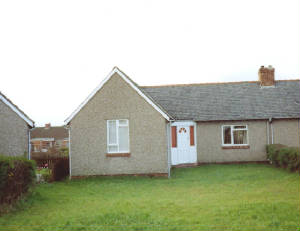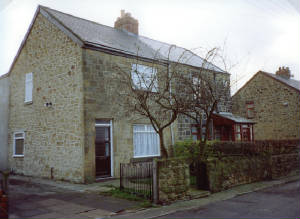|
The
Pritchard family arrived in Eighton Banks when Robert (1868) and Margaret moved from Gateshead (Low Fell) in 1908. The couple with their
six children rented a cottage, No 2, Ravensworth
Avenue.
In 1925 the family moved into a three bedroom council house, No 9, Brown Crescent on a new estate
only a few minutes walk away. Margaret still lived there when she died in 1952
and Robert lived there with his youngest daughter Sarah Jane (Sadie) until he died in 1961.
There was a Pritchard presence in the village until Sarah Jane (Sadie) died in 1992.

9, Brown Crescent, Eighton Banks
The home of Robert (1868) and Margaret Pritchard for 27 years together
and for Robert a further 9 years. A real family home with happy memories
for many of the Pritchard clan. Marion Pritchard was born there on the
14th
of December 1930.
The
Parish of Eighton Banks was formed in 1863 from parts of the parishes of Gateshead
and Chester le Street. The parish church named for St Thomas was
erected in 1853 as a ‘chapel of ease’ to Lamesley on a site given by Thomas Davison of Durham. The principle landowners of Eighton Banks were the Earl of Ravensworth and John Milne
Favell. In 1847 there was a typhus epidemic in the area followed by a cholera epidemic in 1849 when more than tenth of the
population died. The population in 1891 was 2,723.
Eighton
Banks is built on the side of a hill with Springwell up above and Lamesley
down below. The village actually
adjoins Wrekenton and its hard to know where Wrekenton ends and Eighton Banks begins. For much of its history the village
lay between two heavily used colliery Wagonways, the Ouston & Pelaw Wagonway above the village and the Team Colliery Wagonway
below. The Team Colliery Wagonway is now a Cycle Way and a part of the Ouston
& Pelaw is owned and run as a passenger railway by the Bowes Railway Museum. Between Eighton Banks and Washington, Shadons Hill on Black Fell is famed as the site where mass meetings
of pitmen were held which were landmarks in the history of the miners union. On
2nd March 1844 twenty thousand miners agreed to call on mineworkers in other parts of the country to
call a national strike in order to force the coalowners to improve conditions.
Following
a national conference held in Glasgow later that month a further meeting took place on Shadons Hill and more than twenty thousand
pitmen marched behind bands and banners to the meeting and agreed to stop work until their demands had been met. The ‘Big Meeting’ tradition had been set. In 1871
the Durham Miners Union held its first Gala and commonly known as the Big Meeting the tradition continues in July every year. During the 1920s and 1930s Robert Pritchard and his sons followed their banner to
the City of Durham on Gala Day.

No 8, Jubilee Avenue, Eighton Banks
George Pritchard (1897) and his wife Nellie lived here with their family during
the 1930s and following their move to Gateshead, William Pritchard (1903),
his wife Edna and their daughter Gwen lived in the house.
|

